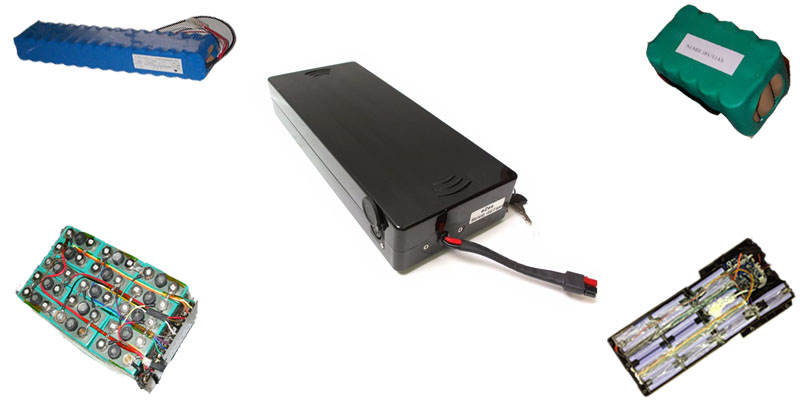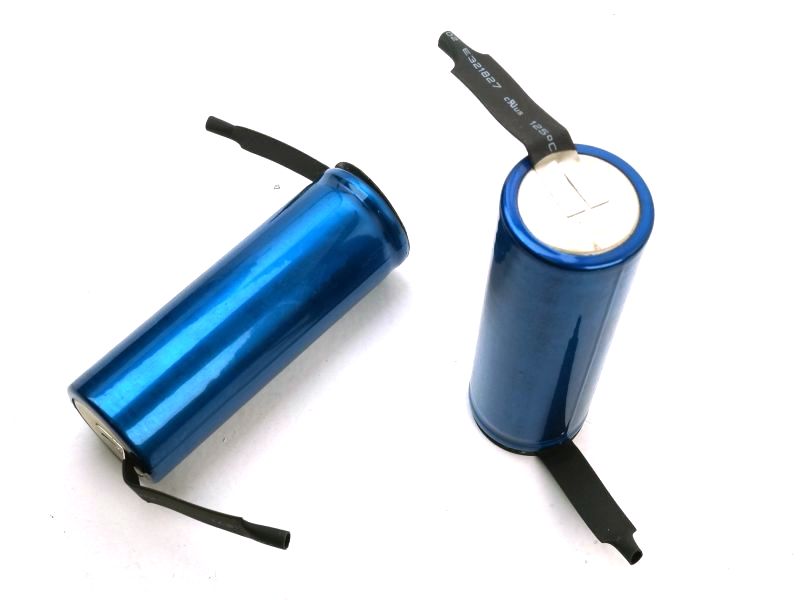Batteries
This page is embarrassingly old, referencing chemistries that are completely obsolete, and is due for a rewrite. In the meantime, we recommend checking out our Battery Kits Product Info page for a more current explanation on lithium specific battery packs.
BEGIN OLD CONTENT

The battery pack is one of the defining aspects of any PEV project; by and large it determines the weight, range, and cost of the vehicle. For these reasons a solid understanding of the various battery types is more than a little useful.
General Battery Types
While there are a lot of chemical combinations that can and have been made into useful batteries, in practice there are only four rechargeable types readily available in sizes suitable for ebikes. These are Lead Acid (PbA), Nickel Metal Hydride (NiMH), Nickel Cadmium (NiCad), and Lithium-ion or Lithium Polymer.
For a long time, lead acid has been the defacto standard for EV's. The cost is low and the chemistry well understood: Always charge up the lead acid battery whenever you can, never leave it in a flat state, expect only 60-70% of the rated amp-hours, and be glad if you get 200 cycles in a deep discharge environment. Probably 80% of all ebikes sold around the world still use lead acid battery packs, but their days are limited. The weight of lead needed to propel a bicycle for a decent 40-50km range is simply too much for a bicycle to easily handle.
Nickel Cadmium was the old standard for rechargeable consumer cells in the familiar AA, C, 9V series. They are known for robust characteristics, a good cycle life, and high discharge capabilities. They are still widely used in cordless power tools, R/C toys and similar applications that demand large currents, but for nearly everything else NiCad's have been replaced by NiMH and Lithiums.
Nickel Metal Hydride is quite similar to Nickel Cadmium, but with a higher energy density and a safer environmental record when disposed of in landfills. This is the dominant rechargeable battery type in digital cameras and other consumer products that offer user replaceable cells.
Almost all consumer electronics that have a plug-in charger these days are powered with lithium batteries because they can store about 3 times more energy than NiMH. Small devices like cell phones, mp3 players, and other gadgets typically have lithium-polymer packs, as these can be formed in conveniently shaped thin rectangular pouches. Larger devices like laptops and the new lithium cordless power tools generally use cylindrical Lithium-ion cells of a size smaller than a 'C' but bigger than a 'AA'. These are spot welded in series/parallel combination to give an appropriate voltage and capacity for the job.
Battery Chemistries
There are six rechargeable battery types that have seen regular use in electric bicycle battery packs. We have never been involved with lead acid batteries, and discontinued dealing NiCad and NiMH packs in 2010.
Lead Acid
Lead acid batteries are the least expensive and heaviest battery option. They have a short cycle life if used regularly in deep discharge applications. For electric bikes, the most common setups use 12V bricks of either 7Ah or the larger 12Ah capacities, series connected to form 36V or 48V packs. Because of the Peukert effect, the 7Ah gel cell usually delivers about 4 amp-hours of actual capacity, while the 12Ah lead acid packs will deliver approximately 8 amp-hours. So keep this in mind when comparing a lead acid pack to one of the NiCd, NiMH, or lithium replacements. We do not offer lead acid batteries or chargers, but they are not hard to find.

Nickel Cadmium
In the rush to upgrade from lead acid to the latest NiMH and lithium packs, it seems that most companies forgot about the old venerable Nickel Cadmium battery as a suitable option for ebikes. Although they are somewhat heavier than the NiMH and lithium options, they are still a substantial weight savings over lead. NiCd packs have had a solid and proven track record in demanding rechargeable battery applications.
NiMH
Nickel Metal Hydride batteries are about 20% lighter and 30% less voluminous than a NiCd pack of the same capacity. They have similar discharge and charge characteristics, but because of the higher energy density they are available in higher capacities than NiCd packs. Because NiMH is safe for disposal in the landfill while Nickle Cadmium is not, the metal hydride has almost completely replaced cadmium in most consumer batteries.
Lithium Polymer
Lithium Polymer is by far the lightest battery option out there. LiPoly cells that can handle very high discharge currents are becoming widely available and are especially popular in the R/C crowd for electric airplanes and helicopters, but ebike LiPoly packs are often made with cells that are only rated to 1C or 2C, and these don't usually deliver a very good cycle life count. The cells are produced in a thin plastic pouch rather than a metal can, making them structurally quite vulnerable unless supplied with a rigid enclosure. Although Lithium Polymer has a reputation for being volatile and failing with spectacular pyrotechnics, there are companies making cells these days that are quite stable and can pass the fullUN 38.3 overcharging and puncture tests without any flames.

Lithium Manganese
This is by far the most common lithium-ion chemistry used in electric bicycles. It is somewhat heavier than lithium polymer and the lithium-cobalt packs that are usually used laptops and consumer electronics, but is also safer. Most of the lithium manganese packs we have dealt with use rectangular steel canned cells and have good discharge capabilities. This chemistry holds its voltage better over the course of the battery discharge than Lithium Polymer, which tends to have a linearly declining voltage from 4.2 to 2.9 volts/cell during the course of the discharge, leading to a ebike that starts off feeling peppy and finishes feeling lethargic.
Lithium Iron Phosphate
The lithium iron phosphate (LiFePO4) battery has had a lot of hype and media attention lately. This is the same chemistry used by A123 in the Dewalt power tool battery packs, where it has a 2000 charge and discharge cycle warrantee and has phenomenal current handling capability. The LiFePO4 batteries sold for ebike use generally have much lower current ratings, and the actual number of charge and discharge cycles that these generic packs will provide remains to be seen, although most manufacturers seem happy to claim 1500 to 2000 cycles. Iron Phosphate lithium packs are only slightly lighter than NiMH and a fair bit more expensive, but they could be the most economical in the long run.
Battery Basics and Terminology
Voltage
Battery packs are made up of individual cells connected together. Each cell has a more or less constant voltage dependent on its chemistry. For NiCad/NiMH, this is about 1.2V, for lead acid it is 2.0V, and for lithium cells it is on the order of 3.7V. Typical ebikes and scooters are designed to run on 24, 36, or 48 Volts, so a number of cells have to be series connected into a 'battery' that has the desired net voltage. A nominal 36V pack could be made from 10 lithium cells, 18 lead acid cells, or 30 NiMH cells.
Amp-Hours
As you draw current from a battery pack, the voltage will very slowly decrease until the cells start to go flat and then the voltage will plummet. The time that the battery lasts for is directly related to its capacity, measured in amp-hours (Ah). A pack that can deliver 1 amp for 1 hour has a capacity of 1 Ah. Most ebike batteries are on the order of 10 amp-hours. Suppose your bike uses 15 amps on average and has a 10Ah pack, then you would expect it to last for - quick, mental calculation... - 40 minutes.
In general, the size and cost of a cell will scale directly with its amp-hour capacity. To a first order, twice the amp-hours would mean twice the size, twice the weight, and twice the cost. In practice this deviates a little due to different packing densities and production scales, but it's usually pretty close. For instance, the familiar 'AA' NiMH has about 2 Ah, a 'C' cell has 4 Ah, a 'D' cell is about 8Ah, the large 'F' cells are 12-13 Ah, and double-D cells are 18-19Ah.
Watt Hours
The figure that matters most when comparing how far a given battery pack will take you is not the amp-hour capacity but the total energy stored watt-hours. To make things more familiar, one watt-hour is one-thousandth of a kWh, the unit of energy used to measure household electrical usage. The watt-hours stored in a battery pack is approximated by taking the actual amp-hours and multiplying it by the pack voltage.
A higher voltage setup therefore needs fewer amp-hours to deliver the same range. So a 24V 8Ah battery can deliver 192 watt-hours, while a 48V 4Ah pack also has 192 watt-hours. Assuming that both batteries are of the same chemistry, then you could expect they would weigh the same, cost the same, and provide the same performance on appropriately designed ebikes (ie, one designed for 24V and the other for 48V).
192 watt-hours is about the smallest battery size you would want for an ebike. Many of the store-bought ebikes have about this much capacity since it keeps the battery cost down. For people who want to actually commute reasonable distances of 40-50km, then I would recommend on the order of 400 watt-hours. While it can vary a lot with usage habits, an energy consumption of 9-10 watt-hrs / km is typical on normal direct-drive setups.
Energy Density
When comparing between battery chemistries, one of the most relevant metrics is the Energy Density in watt-hrs / kg. This figure says how heavy a battery pack will have to be to achieve a certain range. For Lead Acid it is 20-30 whrs/kg, for NiCad it is 35-40 whrs/kg, NiMH is 50-60 whrs/kg, Li-ion is ~110 whrs/kg, and Li-Polymer is up to 160 whrs / kg. Knowing these values makes it easy to project the weight of a pack without having to look up data from the manufacturer.
C Rate
One term you will frequently come across is the 'C' rate of a battery pack. This is a way of normalizing the performance characteristics so that batteries of different capacity are compared on equal terms. Suppose you have an 8 amp-hour pack. Then 1C would be is 8 amps, 2C would be 16 amps, 0.25C would be 2 amps etc. A higher 'C' rate of discharge is more demanding on the cells, and often requires specialty high rate batteries.
For example, suppose you see a 24V 4Ah NiMH battery pack on ebay, that is rated for 1C continuous and 2C max for short times. You might want to get two of these to make a 48V 4Ah battery for your ebike. You calculate that the range will be more than adequate for your short commute to work and back. The problem is that 1C is just 4 amps, while your ebike will probably draw 10-20 amps. If these cells are subject to such discharge rates, then the voltage will sag considerably, leading to slower performance, and the cycle life of the packs will be greatly reduced.
Most inexpensive NiMH packs are not really designed for discharges greater than 1C. That means that if your ebike draws 15 amps on average, you would want a pack that has a capacity on the order of 15 amp-hours more.
How do I choose a pack?
The process of selecting a battery pack typically goes through the following process:
Step 1: Determine your voltage
In many situations, especially if you are replacing a battery pack on an existing setup, the voltage is defined by the controller electronics and cannot be readily changed. Otherwise, the voltage determines the maximum speed at which your vehicle will travel, and you have a degree of freedom in selecting the voltage to meet your performance expectations. If you know the volts/rpm for the motor, then it is straightforward to calculate how fast it will go for a given voltage. Select a value that gives an unloaded speed of about 20% greater than your desired cruising speed for best performance.
While it is possible to build packs with any number of cells for just about any voltage, most have standardized in 12V increments, with 24V, 36V, and 48V being most common, and 72V used on occasion. Battery chargers are usually only stocked for these voltages as well.
Step 2: Determine your minimum capacity
With the voltage known, the next item to figure out is how many amp-hours will be required to achieve your desired trip distance without the battery running flat. This depends of course on how much pedaling you contribute to the effort, how fast you are traveling, and the terrain you are on. The following table is based on minimal pedaling effort.
| Motor Type | Rough energy usage |
| Minimal Assist (using motor only on hills, slower ~30kph setup) | 6-8 Wh/km |
| Typical Assist (~40 kph with pedaling, motor on all the time) | 9-12 Wh/km |
| Power Hungry (either no pedaling, or hauling a load, or going really fast) | 14-20 Wh/km |
Now take your trip distance, multiply it by the appropriate watt-hours/km from the table above, and you'll get the total minimum watt-hours required for the trip. Take the watt-hours you've estimated and divide it by the voltage, and you now have an estimate on the minimum amp-hours you'll need from the pack.
For even more information you can consult the motor simulator to see how your setup will fare in the real world.
Step 3: Choose your chemistry
Now you have the required specs on the pack, namely its voltage and capacity, so it's a matter of finding one that meets your budget and weight restrictions. To a first order, for a given voltage and capacity, NiCad will cost twice as much as lead acid but come in at half the weight, NiMH will be 30% lighter and more expensive than NiCad, and lithium will be twice the cost of NiMH and a further half the weight again.


 Canadian
Canadian